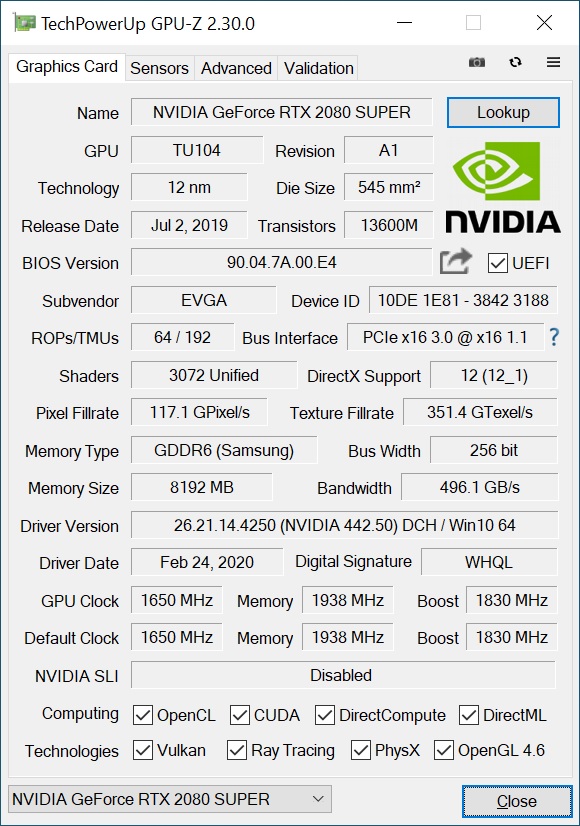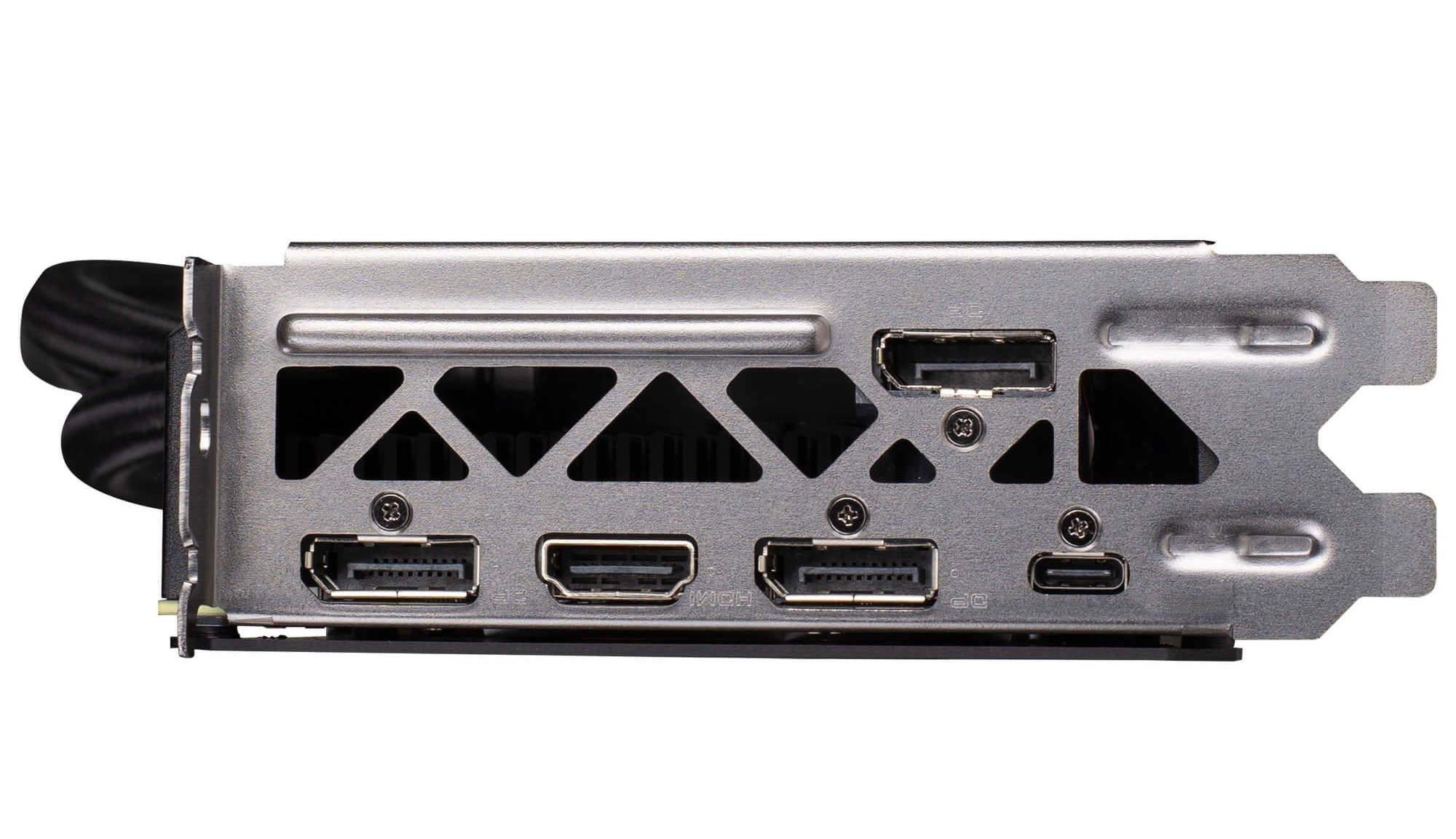Tom's Hardware Verdict
The EVGA RTX 2080 Super XC Hybrid performed well, averaging over 100 fps at 1440p ultra and 60 fps at 4K ultra. The hybrid cooling kept the card much cooler than other cards, but the pump has a soft hum. Priced at $789.99, it's one of the most expensive 2080 Super cards available, but only similar Hybrid setups can cool as well.
Pros
- +
Lower temperatures yield higher average boost clocks
- +
Reduced heat dump inside your PC case
Cons
- -
Higher price than many air-cooled models
- -
Pump hum can be heard over system fans
- -
Requires more space for the card and radiator
Why you can trust Tom's Hardware
Over the past few months, we’ve looked at several Turing based Nvidia cards, which are some of the best graphics cards available and often rate near the top of our GPU hierarchy. None of them have been quite like the EVGA RTX 2080 Super XC Hybrid, which consists of both an air cooler and an integrated liquid cooling solution to keep the GPU and memory frosty. In theory, that should keep temperatures down and allow boost clocks to run a bit higher than most air-cooled solutions while potentially cutting down on noise.
The EVGA RTX 2080 Super Hybrid XC we have for review comes with a small factory overclock (+15 MHz boost over reference speeds) on the core and the same 1,938 MHz (15.5 Gbps) clock speed on the RAM. We’ll see how this card and its hybrid cooling solution compares to the RTX 2080 Ti Founders Edition (FE), Asus ROG Strix RTX 2080 Super OC, RTX 2080 Super FE, and an RTX 2070 Super FE from the Nvidia side. Representing AMD in this review is an ASRock RX 5700 XT Taichi, Radeon VII, and reference RX 5700 and 5700 XT.
While performance was similar between the EVGA Hybrid XC and the other 2080 Super cards, the differences between them are found in the cooling solutions, features and price. At the time of this writing, both the EVGA RTX 2080 Super Hybrid XC and the Asus ROG Strix are priced around $780 while the Nvidia RTX 2080 Super Founders Edition normally goes for $700 (assuming you can find it in stock). ASRock’s RX 5700 XT Taichi is priced at $439.99 by comparison, and the RTX 2070 Super nominally goes for $500 (again, when it's in stock).
For this review, we'll look at performance differences in frames per second (fps), how the hybrid cooler performed compared to traditional air-cooled cards, power consumption, and overall value.
Features
Though there are some differences between the 2080 Super and other RTX models (such as the SM count and subsequently shaders, TMUs, and ROPs), all RTX 2080, 2080 Super, and 2070 Super cards sport the same Turing TU104 silicon under the hood. The TU104 die is manufactured on TSMC’s 12nm FFN (FinFET Nvidia) process using 13.6 billion transistors on a 545mm square die. All three TU104 cards come with 8GB of GDDR6 sitting on a 256-bit bus.
Clock speeds on the EVGA RTX 2080 Super Hybrid XC are set at 1,650 MHz base clock with a listed boost clock of 1,830 MHz. Unlike AMD cards, the Nvidia GPUs' listed boost clocks are more of a minimum whereas AMD boost clocks are a maximum (they run a lot closer to the Game Clock). Memory speed for the card is set to 1,938 MHz (15.5 Gbps effective) which yields 496.1 GB/s bandwidth. This configuration is enough for gaming at its target resolutions of 2560x1440 or 3840x2160 (4K UHD).
Nvidia lists the Geforce RTX 2080 Super as a 250W card in Founders Edition form and recommends a 650W power supply. EVGA doesn’t change the power draw or power supply recommendation for the Hybrid XC. 6-pin and 8-pin PCIe power connectors are required.
Get Tom's Hardware's best news and in-depth reviews, straight to your inbox.
The following table summarizes the specifications of the Nvidia GeForce RTX 2080 Ti, RTX 2080 Super and RTX 2080 Founders Editions, along with the EVGA and Asus RTX 2080 Super cards.
| GeForce RTX 2080 Ti FE | GeForce RTX 2080 Super FE | EVGA RTX 2080 Super Hybrid XC | Asus ROG Strix RTX 2080 Super OC | GeForce RTX 2080 FE | |
|---|---|---|---|---|---|
| Architecture (GPU) | TU102-300-K1-A1 | Turing TU104 (450-A1) | Turing TU104 (450-A1) | Turing TU104 (450-A1) | Turing TU104 (400A-A1) |
| SMs | 68 | 48 | 48 | 48 | 46 |
| CUDA Cores | 4352 | 3072 | 3072 | 3072 | 2944 |
| FP32 GFLOPS (Nvidia Boost / AMD Game) | 14231 | 11151 | 11244 | 11428 | 10068 |
| Texture Units | 272 | 192 | 192 | 192 | 184 |
| ROPs | 88 | 64 | 64 | 64 | 64 |
| Tensor Cores / RT Cores | 544 / 68 | 384 / 48 | 384 / 48 | 384 / 48 | 368 / 46 |
| Nvidia Boost/AMD Game Rate (MHz) | 1635 | 1815 | 1830 | 1860 | 1710 |
| Memory Clock (Gbps) | 14 | 15.5 | 15.5 | 15.5 | 14 |
| Memory Capacity | 11GB GDDR6 | 8GB GDDR6 | 8GB GDDR6 | 8GB GDDR6 | 8GB GDDR6 |
| Memory Bus Width (bits) | 352 | 256 | 256 | 256 | 256 |
| Memory Bandwidth (GBps) | 616 | 496 | 496 | 496 | 448 |
| TDP /TBP (Watts) | 260 | 250 | 250 | 250 | 215 |
| Transistor Count (billions) | 13.6 | 13.6 | 13.6 | 13.6 | 13.6 |
| Die Size (mm square) | 754 | 545 | 545 | 545 | 545 |
Design
The EVGA RTX 2080 Super Hybrid XC is a dual-slot video card measuring 10.4 x 4.4 x 1.6 inches (265.6 x 111.2 x 40 mm). The card is full-size and sticks out about an inch past the width of our ATX motherboard, making this a long card though certainly not the biggest we’ve tested. Height shouldn’t be a concern as it sits flush with the I/O plate, but due to the length, it may not fit into small form factor (SFF) systems. Be sure to verify the space inside your chassis before buying.
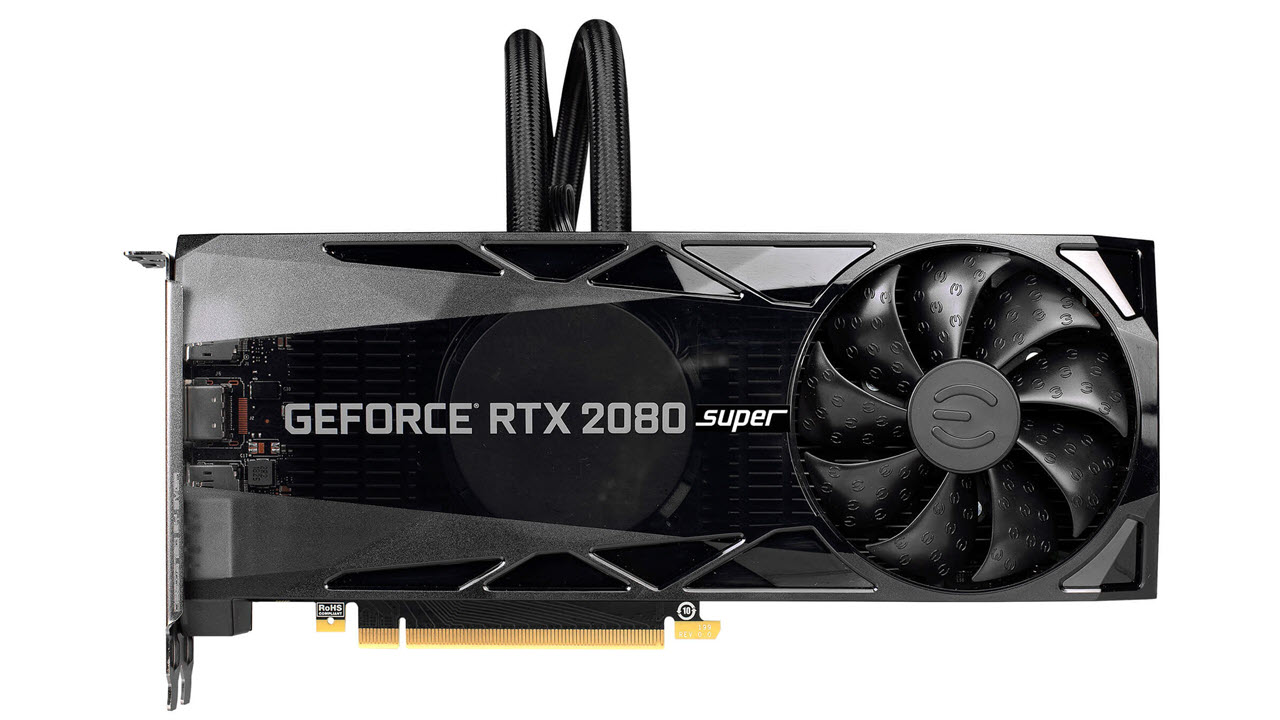
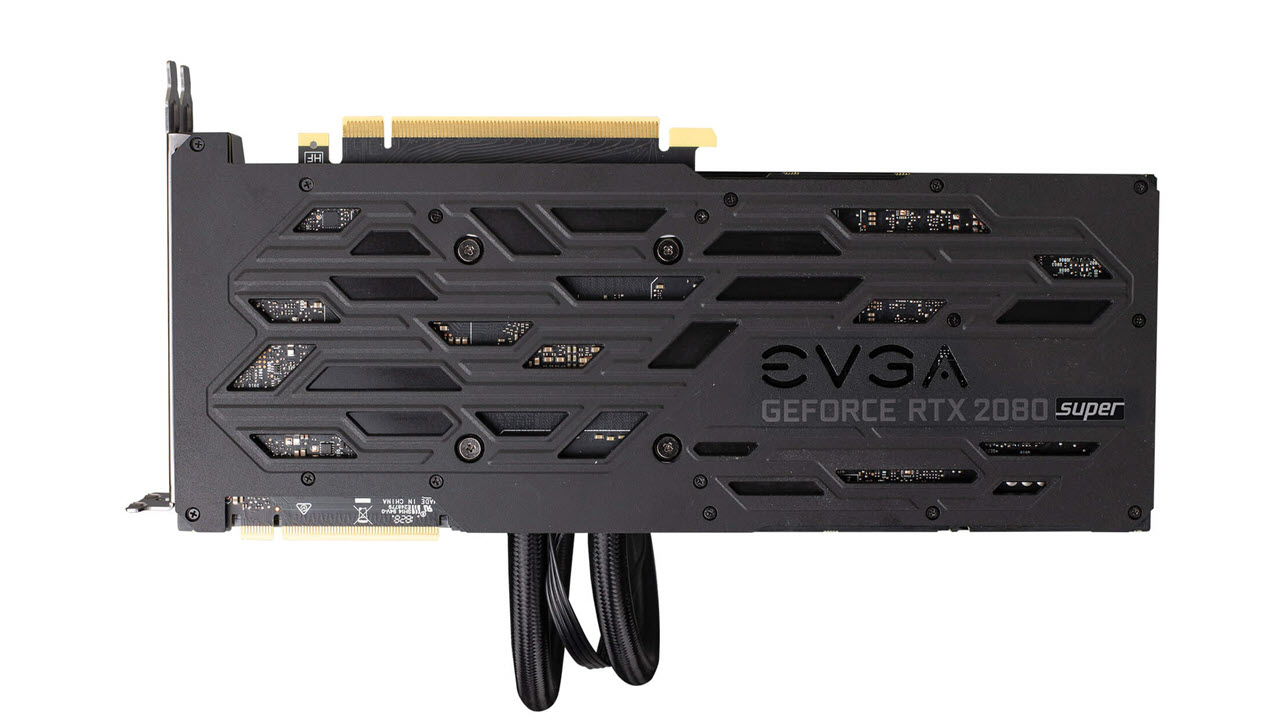
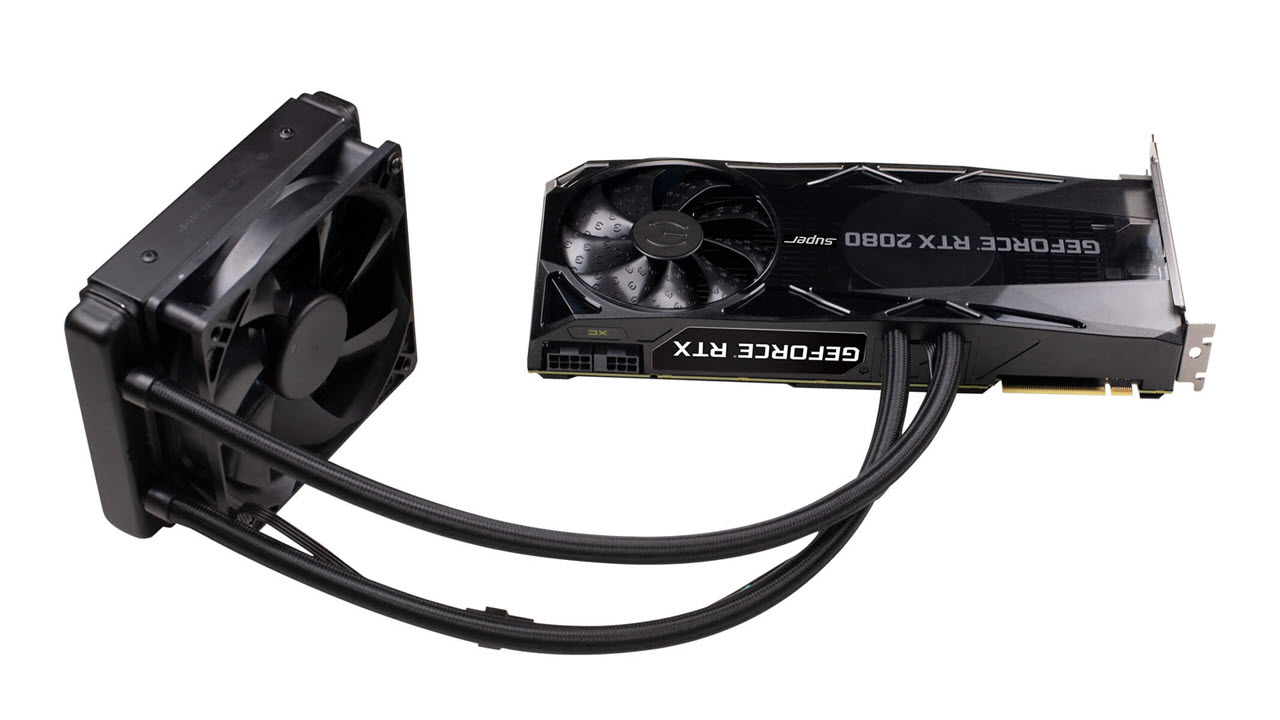

Like air-cooled cards, our Hybrid cooled EVGA uses a stylish plastic shroud with the GeForce RTX 2080 Super name stenciled across its smoked tinted cover. On top is “EVGA Hybrid” naming lit up through the only RGBs we find. On the right is a single ~85mm fan attached directly to a large heatsink, which blows cool air across the VRMs and out the rear and I/O side. The back of the card sports a matte black powder-coated metal backplate that protects the rear of the PCB and helps passively cool the VRMs.
In order to cool the GPU and memory, a 120mm radiator attaches directly to the GPU core while a dedicated memory plate makes direct contact with the water cooling block for optimal memory temperatures. Attached to the high fins per inch (FPI) radiator is a swappable 120mm fan that does a good job moving air quietly. Both fans have their own custom curves and can be controlled manually through EVGA Precision X1 software. The VRM fan remains off during idle and low load operation, helping to minimize noise.
The EVGA RTX 2080 Super Hybrid XC uses a reference PCB sporting an 8+2 phase (GPU and Memory) VRM setup. The GPU VRM is controlled by an 8-channel uP9512P part, while the memory VRM is controlled by a uP9529P controller. The GDDR6 chips hidden below the memory plate are made by Samsung (P/N K4Z80325BC-HC16) and specified to run at 2000 MHz (16 Gbps effective). Even though this is a reference board, Nvidia did a good job ensuring the power delivery system could handle stock and overclocked operation.
I/O ports on the EVGA card are standard fare for high-end Turing and include three DisplayPorts (1.4b), a single HDMI (2.0b) port and a VirtualLink USB Type-C port designed for VR headsets.
How We Tested the EVGA RTX 2080 Super XC Hybrid
Our current graphics card test system consists of Intel's Core i9-9900K, an 8-core/16-thread CPU that routinely ranks as the fastest overall gaming CPU. The MSI MEG Z390 Ace motherboard is paired with 2x16GB Corsair Vengeance Pro RGB DDR4-3200 CL16 memory (CMK32GX4M2B3200C16). Keeping the CPU cool is a Corsair H150i Pro RGB AIO, along with a 120mm Sharkoon fan for general airflow across the test system. Storing our OS and gaming suite is a single 2TB Kingston KC2000 NVMe PCIe 3.0 x4 drive.
The motherboard is running BIOS version 7B12v17. Optimized defaults were used to set up the system. We then enabled the memory's XMP profile to get the memory running at the rated 3200 MHz CL16 specification. No other BIOS changes or performance enhancements were enabled. The latest version of Windows 10 (1909) is used and is fully updated as of March 2020.
Our GPU hierarchy provides a complete overview of the GPUs at the heart of various graphics cards and how the various models stack up against each other. For these individual third-party card reviews, we primarily focus on GPUs that compete with and are close in performance to the card that is being reviewed. However, we've overhauled our charting system and are including multiple other GPUs now. The main points of interest will be the RTX 2080 Ti FE, RTX 2080 Super FE, RTX 2070 Super FE along with an Asus ROG Strix RTX 2080 Super OC. For AMD, we have the Radeon VII, RX 5700 XT and RX 5700 reference cards, along with an ASRock RX 5700 XT Taichi.
Our list of test games is currently Borderlands 3, The Division 2, Far Cry 5, Final Fantasy XIV: Shadowbringers, Forza Horizon 4, Metro Exodus, Red Dead Redemption 2, Shadow of the Tomb Raider and Strange Brigade. These titles represent a broad spectrum of genres and APIs, which gives us a good idea of the relative performance differences between the cards. We're using driver build 442.78 for the Nvidia cards and Adrenalin 20.4.1 drivers for AMD.
We capture our frames per second (fps) and frame time information by running OCAT during our benchmarks. For The Division 2 and Metro Exodus we use the .csv files the built-in benchmark creates. For clock and fan speed, temperature and power, we use GPU-Z's logging capabilities. We'll be resuming our use of the Powenetics-based system for graphics card reviews in the near future.
Current page: Features and Specifications
Next Page Performance Results: 2560x1440 (Ultra)
Joe Shields is a staff writer at Tom’s Hardware. He reviews motherboards and PC components.
-
Phaaze88 The TL;DR:Reply
No, no it is not.
I would've thought a liquid cooled gpu like that would've performed a fair deal better than an air cooled model like the ROG Strix...
Did they take a FE 2080 Super PCB and slap the AIO on it? The FE only has a 280w power limit, and Asus Strix has a 313w limit on the OC model. -
Blas It would be nice to see comparisons of the different hybrid cooled cards out there (EVGA's Hybrid, Gigabyte's Waterforce, Inno3D iChill, etc.). I use these for my iTX build, and apparently there are many differences in noise and cooling performance. And while there are some reviews online, it's really hard to come across comparisons.Reply -
willie_t Some of us like to use the high end cards for Folding. Most card reviewers don't give a single sentence in that area as to how various cards do in that arena. So, we have to search that info out in other areas. "It would be nice" to see a reference in video card reviews - even if it's only a sentence or two.Reply -
saunupe1911 Replyadmin said:The EVGA RTX 2080 Super XC Hybrid performed well, averaging over 100 fps at 1440p ultra and 60 fps at 4K ultra. The hybrid cooling kept the card much cooler than other cards, but the pump has a soft hum. Priced at $789.99, it's one of the most expensive 2080 Super cards available, but only similar Hybrid setups can cool as well.
EVGA RTX 2080 Super XC Hybrid Review: Cool Running, but Worth It? : Read more
Why didn't you guys review the FTW3 version of this card which has a higher boost of 1845Mhz? I paid $769 for it too on Newegg back in September. It's actually going for around the same price right now.
Everything in your review is spot on. It rarely eclipses 53 degrees even when it's working it's hardest. It can overclock it's butt off but I put it back to stock as it's really not necessary since I'm gaming on the Dell S3220DGF monitor. The pump wine does sort of bother me but I've gotten used to it. I wish it could be controlled.
The one real issue with this is card is that the radiator fan can't be software controlled with Precision X1 or Afterburner. You can only independently control the GPU fan. All software reports them running at the same speeds which certainly isn't true. -
PBme Reply
Are you aware of any objective way to test that? F@H doesn't have a benchmark tool (that I'm aware of) and of course they can't just sit there hoping they get a WU, wait for 2 hours, repeat to average results, and just cross their fingers that one WU will be the exact same as another from the same day let alone of months.willie_t said:Some of us like to use the high end cards for Folding. Most card reviewers don't give a single sentence in that area as to how various cards do in that arena. So, we have to search that info out in other areas. "It would be nice" to see a reference in video card reviews - even if it's only a sentence or two.
They can perhaps derive it from the other tests done but that specific one would have to be speculation.
